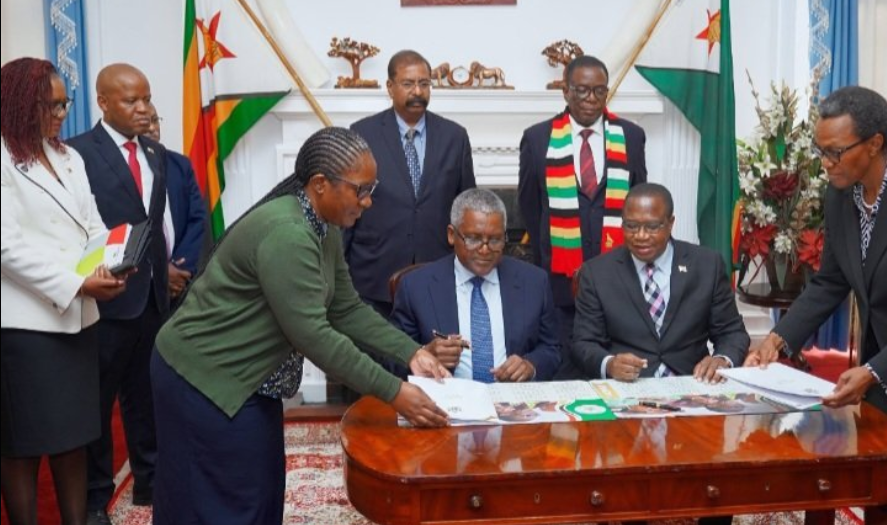The Zimbabwe
National Chamber of Commerce (ZNCC) has urged the Reserve Bank of
Zimbabwe (RBZ) to lower its bank policy rate from the current 35% to 20%
in an effort to ease growing credit constraints in the market and
stimulate production in a liquidity-starved economy.
The
recommendation, contained in the ZNCC's latest report presented at its
annual congress in Victoria Falls, comes amid tightening monetary and
fiscal policies aimed at reinforcing confidence in the newly introduced
Zimbabwe Gold (ZiG) currency. However, the business chamber warns that
these hawkish measures have exacerbated the ongoing liquidity crunch,
threatening to stifle productivity and worsen the country's economic
challenges.
The RBZ hiked the policy rate from 20% to 35% earlier
this year to curb speculative borrowing, a move that has since drawn
concern from both industry and financial experts.
"The central
bank should consider reducing the bank policy rate from 35% to
approximately 20%," ZNCC said. "This adjustment would help alleviate
credit constraints on productive sectors while still maintaining a real
positive interest rate."
In addition to recommending a rate cut,
the Chamber called on the RBZ to reconsider recent increases in
statutory reserve requirements, warning that they may further strain
liquidity in both the local and foreign currency markets. The RBZ had
raised statutory reserve requirements by 15 percentage points for local
currency and 10 percentage points for foreign currency deposits.
Currently,
reserve requirements for savings and time deposits stand at 15% for
both currencies, while demand and call deposits are pegged at a steep
30%.
"These requirements may exacerbate the liquidity strain,"
ZNCC said. "The authorities should re-evaluate these levels to balance
liquidity provision with financial stability."
While
acknowledging that the 2025 Monetary Policy Statement outlines key
commitments - including price stability, exchange rate management, and
efforts to build foreign exchange reserves - ZNCC noted that the real
challenge lies in execution. The Chamber warned that weak market
confidence and poor coordination with fiscal authorities could undermine
the central bank's efforts to stabilise the economy.
"While the
policy intentions are sound, their success will depend on practical
implementation, market response, and alignment with fiscal strategy,"
the report noted.
Concerns about the sustainability of the ZiG
currency and the general macroeconomic environment also loom large,
particularly as inflationary pressures remain and access to affordable
credit continues to dwindle.
Adding his voice at the congress,
banker and financial analyst Tawanda Nyambirai criticised Zimbabwe's
high reserve requirements, saying they were out of sync with regional
standards. He compared Zimbabwe's 30% reserve ratio with South Africa's
2.5%, saying the disparity significantly raises the cost of money in
Zimbabwe.
"When you calculate the cost, if you lend money, you
have to take into account the amount of money that is housed and is
gathered and collected in Zimbabwe," said Nyambirai. "Under such
conditions, local banks cannot operate competitively."
The ZNCC's
recommendations underscore growing pressure on the RBZ to recalibrate
its monetary policy framework to boost credit flows, restore market
confidence, and revive economic activity amid widespread liquidity
shortages. As the ZiG currency continues to define Zimbabwe's new
monetary era, how the central bank responds to these challenges could
determine the broader economic trajectory in the months ahead.
- Newsday
 Zimbabwe launches new airline
Zimbabwe launches new airline  Hichilema meets Chivayo
Hichilema meets Chivayo  Millions celebrate Diwali festival in India
Millions celebrate Diwali festival in India  SA bitcoin firm mulls Zimbabwe listing
SA bitcoin firm mulls Zimbabwe listing  Gold edges up as traders await guidance
Gold edges up as traders await guidance  Airlink applies for Lanseria to Harare, Bulawayo route
Airlink applies for Lanseria to Harare, Bulawayo route  Young Investment Professional (YIP) Graduate Programme 2019
Young Investment Professional (YIP) Graduate Programme 2019 










 Young Investment Professional (YIP) Graduate Programme 2019
Young Investment Professional (YIP) Graduate Programme 2019
Editor's Pick